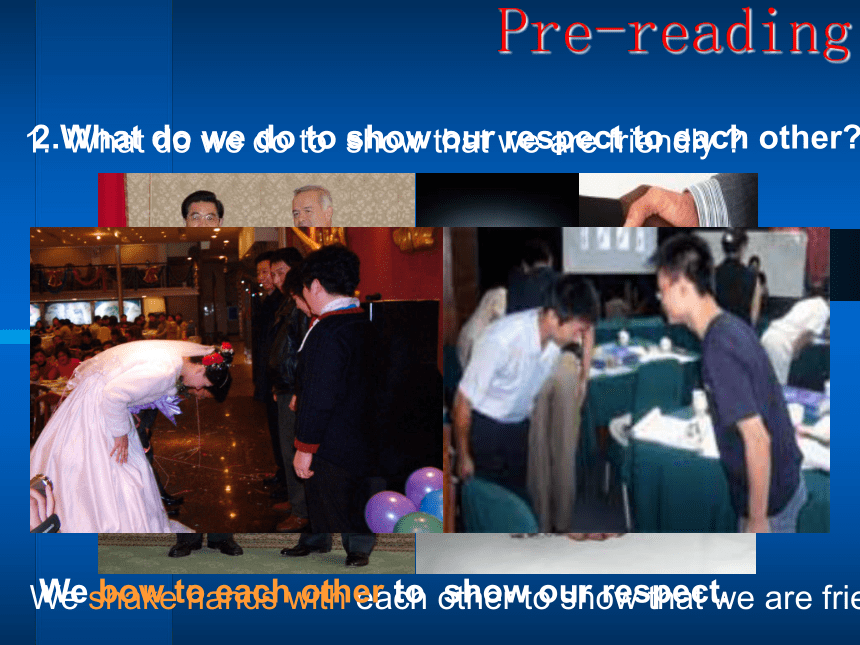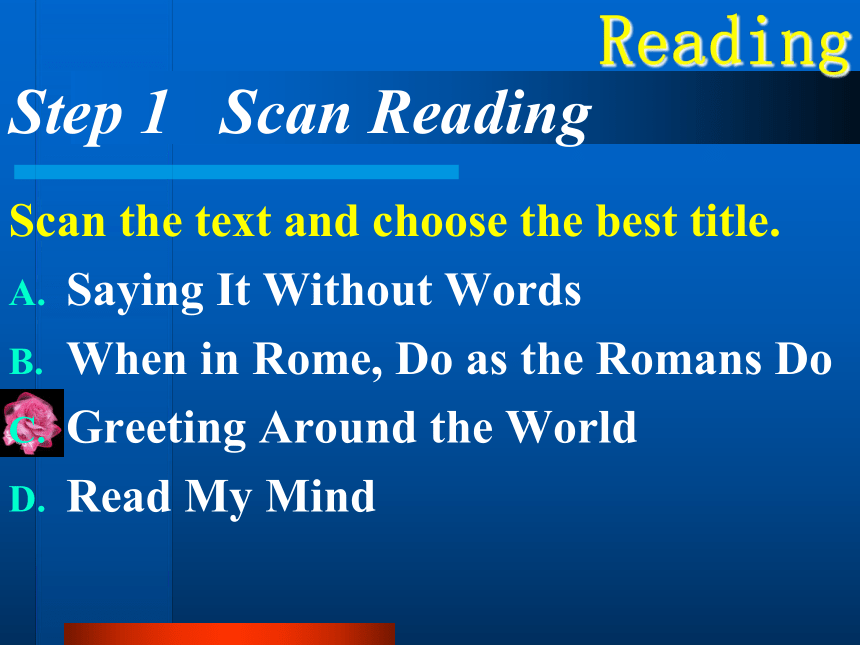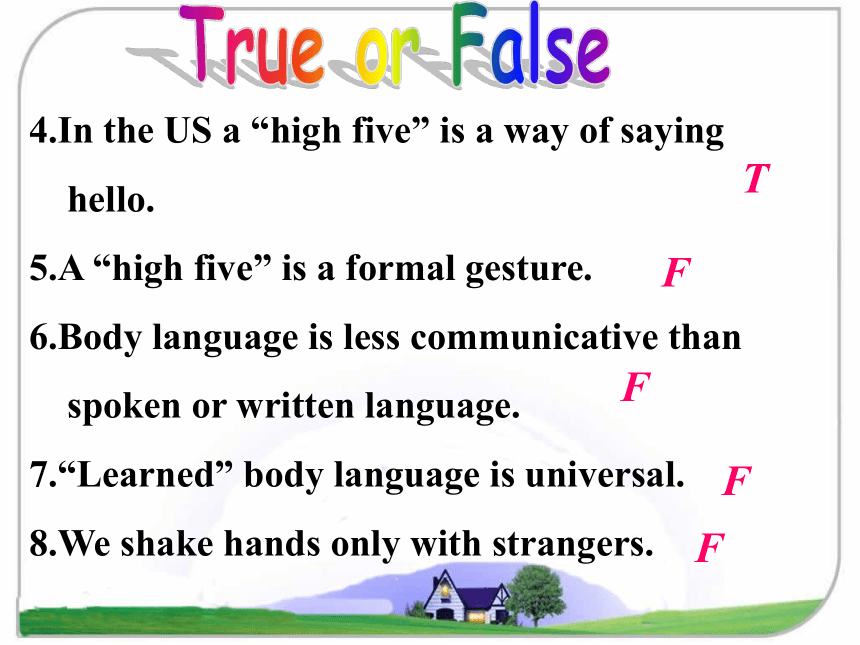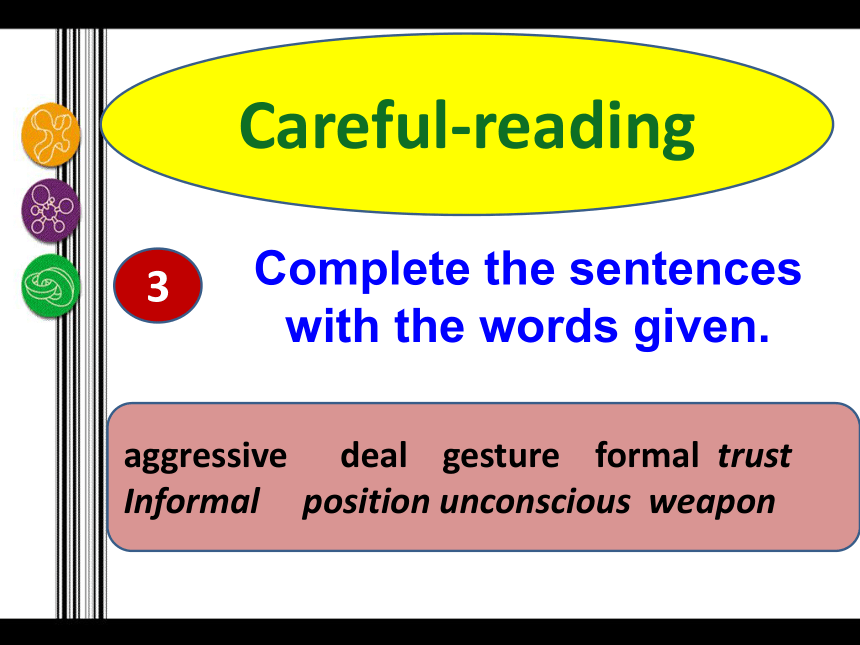英语必修Ⅳ外研版 Module 3 Body Language and Non-Verbal Communication课件
文档属性
| 名称 | 英语必修Ⅳ外研版 Module 3 Body Language and Non-Verbal Communication课件 |  | |
| 格式 | zip | ||
| 文件大小 | 1.6MB | ||
| 资源类型 | 教案 | ||
| 版本资源 | 外研版 | ||
| 科目 | 英语 | ||
| 更新时间 | 2013-06-17 23:14:21 | ||
图片预览







文档简介
课件17张PPT。 Pre-reading 1. What do we do to show that we are friendly ?We shake hands with each other to show that we are friendly.2.What do we do to show our respect to each other?We bow to each other to show our respect.Pre-reading3.Use your facial expressions to show these feelings:happy sad
puzzled
scared angry
Body Language and
Non-verbal Communication
Reading and VocabularyStep 1 Scan Reading Scan the text and choose the best title.
Saying It Without Words
When in Rome, Do as the Romans Do
Greeting Around the World
Read My MindReading Step 2 Fast ReadingFTF 1.Not all body language is
conscious.
2.Europeans shake hands with
their left hand.
3.In Asia, people touch each other
when they meet.Read the text again and say if the following statements are true (T) or false (F)4.In the US a “high five” is a way of saying
hello.
5.A “high five” is a formal gesture.
6.Body language is less communicative than
spoken or written language.
7.“Learned” body language is universal.
8.We shake hands only with strangers.TFFFFTrue or FalseCareful-readingComplete the sentences with the words given.3aggressive deal gesture formal trust
Informal position unconscious weaponGuns and knives are two different types of _____________.
Someone who has a(n) _________ attitude may be violent.
You can _____ someone by saying “Hello”.
Your __________ is the way you are sitting or standing.
If you are ____________ of something you do not know it is happening.weaponsaggressivegreetpositionunconscious6. A(n)_____________ is a business agreement.
7. A(n) _________ is a movement of the body to communicate something.
8. If you _____ someone you believer them and rely on them.
9. “Give me five!” is a(n) __________ greeting.
10. People are usually more ____________ with people they don’t know.dealgesturetrustinformalformalStep 4 RetellingIf you say … ,most people think of… . Although these …, we communicate with …Indeed,… are part of … . We see examples of … ,yet there is …,which …Retell the text paragraph by paragraph after listening:from culture to culture =from one … to anotherfrom door to door, from hand to hand,
from mouth to mouth, from person to personParagraph 1Post Reading Step 4 RetellingEvery culture has developed …to … , to show them … Traditionally,… shake hands. They do this …,the … hand … .If our right hand…,it can not … If you … you show ….We …when we make a deal, It means…be busy doing … =be busy in doing …be on guard Paragraph 2make a deal shake hands with ?make friends withPost Reading Step 4 RetellingGreeting in Asian countries …,but they … . Traditionally in China, when we …, we…. Muslims …, where…. Hindus …and bow … in respect. In all these …, the hands … and can not …in respect?in surprise/disappointment/sorrow/joyParagraph 3Post Reading Step 4 RetellingToday, people still use … as a … . American youths often … “…”. One person …palm …and …. The other…and … above in a …. Nowadays, it is …raise one’s hand?put up/down one’s hand / hold up one’s hand / slap one’s hand/ join one’s hands/cross one’s handsParagraph 4Post Reading Step 4 Acting and expressing 1. meet a friend
2. show someone the way
3. see a friend in the distance
4. enter a friend’s house
5. say yes
6. say no
7.say who? Me?
8.say goodbye
What do you do when you …I shake hands and say: “Nice to meet you.”I point in the direction they must go.I wave my hand.I nod my head up and down.I shake hands and say: “pleased to meet you.”I shake my head from side to side. I point to myself and put on a surprised expression. I shake hands and say: “Goodbye.”Activity Step 5 GuessingGuess this young man is …happysadscaredpuzzledangrysurprisedJamieActivity HomeworkTry to retell the passage.
Finish exercises in workbook on page 80-82.
Preview Grammar in this module.Bye-bye!
puzzled
scared angry
Body Language and
Non-verbal Communication
Reading and VocabularyStep 1 Scan Reading Scan the text and choose the best title.
Saying It Without Words
When in Rome, Do as the Romans Do
Greeting Around the World
Read My MindReading Step 2 Fast ReadingFTF 1.Not all body language is
conscious.
2.Europeans shake hands with
their left hand.
3.In Asia, people touch each other
when they meet.Read the text again and say if the following statements are true (T) or false (F)4.In the US a “high five” is a way of saying
hello.
5.A “high five” is a formal gesture.
6.Body language is less communicative than
spoken or written language.
7.“Learned” body language is universal.
8.We shake hands only with strangers.TFFFFTrue or FalseCareful-readingComplete the sentences with the words given.3aggressive deal gesture formal trust
Informal position unconscious weaponGuns and knives are two different types of _____________.
Someone who has a(n) _________ attitude may be violent.
You can _____ someone by saying “Hello”.
Your __________ is the way you are sitting or standing.
If you are ____________ of something you do not know it is happening.weaponsaggressivegreetpositionunconscious6. A(n)_____________ is a business agreement.
7. A(n) _________ is a movement of the body to communicate something.
8. If you _____ someone you believer them and rely on them.
9. “Give me five!” is a(n) __________ greeting.
10. People are usually more ____________ with people they don’t know.dealgesturetrustinformalformalStep 4 RetellingIf you say … ,most people think of… . Although these …, we communicate with …Indeed,… are part of … . We see examples of … ,yet there is …,which …Retell the text paragraph by paragraph after listening:from culture to culture =from one … to anotherfrom door to door, from hand to hand,
from mouth to mouth, from person to personParagraph 1Post Reading Step 4 RetellingEvery culture has developed …to … , to show them … Traditionally,… shake hands. They do this …,the … hand … .If our right hand…,it can not … If you … you show ….We …when we make a deal, It means…be busy doing … =be busy in doing …be on guard Paragraph 2make a deal shake hands with ?make friends withPost Reading Step 4 RetellingGreeting in Asian countries …,but they … . Traditionally in China, when we …, we…. Muslims …, where…. Hindus …and bow … in respect. In all these …, the hands … and can not …in respect?in surprise/disappointment/sorrow/joyParagraph 3Post Reading Step 4 RetellingToday, people still use … as a … . American youths often … “…”. One person …palm …and …. The other…and … above in a …. Nowadays, it is …raise one’s hand?put up/down one’s hand / hold up one’s hand / slap one’s hand/ join one’s hands/cross one’s handsParagraph 4Post Reading Step 4 Acting and expressing 1. meet a friend
2. show someone the way
3. see a friend in the distance
4. enter a friend’s house
5. say yes
6. say no
7.say who? Me?
8.say goodbye
What do you do when you …I shake hands and say: “Nice to meet you.”I point in the direction they must go.I wave my hand.I nod my head up and down.I shake hands and say: “pleased to meet you.”I shake my head from side to side. I point to myself and put on a surprised expression. I shake hands and say: “Goodbye.”Activity Step 5 GuessingGuess this young man is …happysadscaredpuzzledangrysurprisedJamieActivity HomeworkTry to retell the passage.
Finish exercises in workbook on page 80-82.
Preview Grammar in this module.Bye-bye!
